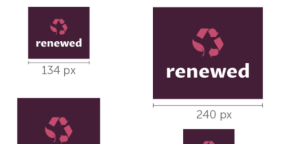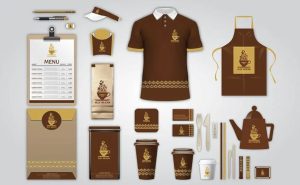Are you looking to create an aesthetically pleasing logo for your business or personal brand? Choosing the right color palette is a crucial step in logo design. Aesthetic color palettes are a popular choice for creating logos that are visually appealing and memorable.
There are a variety of aesthetic color palettes to choose from, each with its own unique vibe and style. Earthy colors, such as desert sand and muted sage greens, create a calming and professional effect, making them a great choice for consultants, beauty businesses, and outdoor brands. On the other hand, bright and bold colors, like neon pinks and electric blues, can create a playful and energetic vibe, perfect for youth-oriented brands or creative businesses.
In addition to choosing the right color palette, it’s important to consider other design elements when creating an aesthetic logo. Typography, imagery, and overall layout all play a role in creating a cohesive and visually appealing logo. By taking the time to carefully consider these elements, you can create a logo that not only looks great but accurately represents your brand and its values.
Understanding Aesthetic Colors in Logo Design
When it comes to logo design, choosing the right colors can make all the difference in creating an aesthetic and memorable brand identity. Aesthetic colors are those that are visually pleasing and evoke a particular mood or emotion. In logo design, aesthetic colors are used to create a brand image that resonates with the target audience and helps to differentiate the brand from its competitors.
One of the most important aspects of choosing aesthetic colors for logo design is understanding color psychology. Different colors have different meanings and can evoke different emotions in people. For example, red is often associated with passion and excitement, while blue is associated with calmness and trustworthiness. By understanding the psychology of colors, you can choose colors that will evoke the desired emotions in your target audience.
Another important consideration when choosing aesthetic colors for logo design is brand identity. Your logo should reflect the values and personality of your brand. For example, a luxury brand may use gold or silver to convey elegance and sophistication, while a fun and playful brand may use bright and bold colors to convey a sense of energy and excitement.
It’s also important to consider the overall aesthetic of your brand when choosing colors for your logo. Your logo should fit in with the rest of your branding, including your website, social media profiles, and marketing materials. Creating a brand style guide can help ensure consistency in the use of colors and other design elements across all of your marketing materials.
In summary, understanding aesthetic colors and their impact on logo design is crucial for creating a strong and memorable brand identity. By considering color psychology, brand identity, and overall aesthetic, you can choose colors that will resonate with your target audience and help to differentiate your brand from its competitors.
The Role of Color Psychology in Logo Design
When it comes to logo design, color is one of the most important elements to consider. Color psychology studies the impact of colors on human behavior and emotions, and it can be a powerful tool in logo design. Here are some of the ways in which color psychology can be used to create effective logos that resonate with your target audience.
Warm Colors and Their Meanings
Warm colors, such as red, orange, and yellow, are associated with passion, energy, and optimism. They are often used in logos for companies that want to convey a sense of excitement and enthusiasm. Here are some of the meanings associated with warm colors:
- Red: Passion, love, power, and confidence
- Orange: Trust, energy, playfulness, and optimism
- Yellow: Happiness, creativity, warmth, and friendliness
Cool Colors and Their Significance
Cool colors, such as green, blue, and teal, are associated with calmness, trust, and stability. They are often used in logos for companies that want to convey a sense of professionalism and reliability. Here are some of the meanings associated with cool colors:
- Green: Growth, health, nature, and tranquility
- Blue: Trust, loyalty, wisdom, and intelligence
- Teal: Sophistication, creativity, and balance
Neutral Colors and Their Impact
Neutral colors, such as black, white, gray, brown, beige, and taupe, are often used in logos for companies that want to convey a sense of simplicity, elegance, and timelessness. Here are some of the meanings associated with neutral colors:
- Black: Power, sophistication, and elegance
- White: Purity, simplicity, and clarity
- Gray: Balance, neutrality, and sophistication
- Brown: Earthiness, stability, and warmth
- Beige: Calmness, relaxation, and simplicity
- Taupe: Sophistication, warmth, and elegance
In conclusion, color psychology plays a crucial role in logo design. By choosing the right colors for your logo, you can create a powerful visual identity that resonates with your target audience. Whether you want to convey excitement, professionalism, simplicity, or elegance, there is a color palette that can help you achieve your goals.
Creating a Color Palette for Your Logo
When designing a logo, choosing the right color palette is crucial for creating a strong brand identity. A well-designed color palette can make your logo stand out and communicate your brand’s values and personality. In this section, we’ll go over some tips for creating a color palette for your logo.
Choosing the Right Color Combinations
When selecting colors for your logo, it’s important to consider color theory and complementary colors. Complementary colors are colors that are opposite each other on the color wheel, and they can create a striking and visually appealing contrast. For example, pairing a deep purple with a mustard yellow can create a bold and eye-catching color combination.
Another approach to choosing colors for your logo is to look to nature for inspiration. Colors found in plants, flowers, leaves, and stems can create a natural and organic feel for your brand. For example, a color palette featuring shades of terracotta, sand, clay, stone blue, pine, and other earthy tones can evoke a sense of nature and sustainability.
Incorporating Aesthetic Colors
Aesthetic colors, such as violet, lavender, and other pastel shades, have become increasingly popular in recent years. These colors can create a soft and dreamy aesthetic that can be perfect for brands that want to communicate a sense of creativity, imagination, and playfulness.
When incorporating aesthetic colors into your logo, it’s important to balance them with other colors that can provide contrast and balance. For example, pairing a soft lavender with a bold black or deep navy can create a sophisticated and elegant look.
In conclusion, creating a color palette for your logo is an important step in establishing a strong brand identity. By considering color theory, complementary colors, and nature-inspired tones, you can create a logo that communicates your brand’s values and personality. Don’t be afraid to experiment with different color combinations and seek inspiration from the world around you.
The Impact of Logo Design on Brand Identity
When it comes to branding, your logo is the face of your company. It is often the first thing that potential customers see and can make a lasting impression. A well-designed logo can help establish brand identity and recognition, while a poorly designed logo can have the opposite effect. In this section, we will explore the impact of logo design on brand identity, including logo types, colors, design elements, and how to use social media to showcase your logo design.
Logo Types and Their Influence
There are several types of logos, including wordmarks, lettermarks, pictorial marks, abstract marks, and combination marks. Each type has its own unique influence on brand identity. For example, a wordmark logo is a text-only logo that can be effective for companies with a distinctive name, while an abstract mark can help convey a more creative or artistic brand image.
Logo Colors and Brand Perception
The colors used in a logo can have a significant impact on brand perception. Different colors evoke different emotions and associations, and it’s important to choose colors that align with your brand identity. For example, blue is often associated with trust and reliability, while red can evoke excitement or passion. It’s important to consider color psychology when designing your logo.
Design Elements that Enhance Logo Aesthetics
In addition to color, there are several design elements that can enhance the aesthetics of your logo. These include typography, negative space, and symmetry. A well-designed logo should be simple, memorable, and easily recognizable. It’s important to consider how your logo will look across different mediums, such as print and digital.
Using Social Media to Showcase Your Logo Design
Social media can be a powerful tool for showcasing your logo design and building brand identity. By sharing your logo on social media platforms, you can increase visibility and engagement with your brand. It’s important to use social media strategically and consistently to reinforce your brand identity.
How Logo Design Can Distinguish You from Competitors
A well-designed logo can help distinguish your brand from competitors. By creating a unique and memorable logo, you can establish a strong brand identity and stand out in a crowded market. It’s important to consider your target audience and competitors when designing your logo, and to create a design that is both distinctive and relevant to your brand.
In conclusion, logo design is a critical component of brand identity. By choosing the right logo type, colors, and design elements, you can create a logo that effectively communicates your brand identity and sets you apart from competitors. By using social media to showcase your logo design, you can increase visibility and engagement with your brand.
Case Studies: Successful Aesthetic Logo Designs
Aesthetic logos have become increasingly popular in recent years, and for good reason. A well-crafted aesthetic logo can elevate your brand’s identity and leave a lasting impression on your audience. Let’s take a look at some successful case studies of aesthetic logo designs.
Glossier
Glossier is a beauty brand that has become known for its minimalist aesthetic. Their logo is a simple, sans-serif font in a soft pink color. The logo perfectly reflects the brand’s identity and has become instantly recognizable. The color choice is also important, as the soft pink conveys a sense of femininity and approachability.
Supreme
Supreme is a streetwear brand that has become a cultural phenomenon. Their logo is a bold, sans-serif font in white on a red background. The logo has become iconic and is instantly recognizable among streetwear enthusiasts. The color choice is important here as well, as the red background conveys a sense of energy and urgency.
Airbnb
Airbnb is a travel company that has become known for its unique and personalized travel experiences. Their logo is a simple, sans-serif font in a bright red color. The logo perfectly reflects the brand’s identity and has become instantly recognizable. The color choice is important here as well, as the bright red conveys a sense of excitement and adventure.
Glossier, Supreme, and Airbnb
What do these three brands have in common? They have all successfully used aesthetic logo design to elevate their brand identity. Each logo is simple yet effective, with a clear font choice and color scheme that perfectly reflects the brand’s identity. When designing an aesthetic logo for your brand, it’s important to keep in mind the message you want to convey and choose a font and color scheme that supports that message.
Consulting with Design Professionals
When it comes to creating an aesthetic brand identity, consulting with design professionals can be a wise decision. Designers and consultants have the expertise and experience necessary to create a logo design that accurately reflects your brand and resonates with your target audience.
A professional designer can help you create a custom logo design that is unique to your brand and communicates your message effectively. They can also provide guidance on color schemes, typography, and other design elements that will help you create a cohesive brand identity.
One option for creating a logo design is to use a logo maker such as Looka. With Looka, you can create a professional-looking logo design quickly and easily. The platform offers a range of customizable templates and design elements that you can use to create a logo that fits your brand.
Whether you choose to work with a professional designer or use a logo maker, it’s important to keep your brand identity in mind throughout the design process. Your logo should reflect your brand values and communicate your message clearly to your target audience.
Overall, consulting with design professionals can be a valuable investment in your brand. By working with a designer or using a logo maker, you can create a logo design that accurately represents your brand and helps you stand out in a crowded marketplace.
Conclusion
In conclusion, designing an aesthetic logo that reflects your brand identity requires careful consideration of color combinations, shapes, and best design practices. Your logo is the face of your brand, and it is essential to create a captivating design that resonates with your target audience.
When designing your logo, keep in mind the meaning and psychology behind each color. For example, red is often associated with passion and excitement, while blue is associated with trust and reliability. By selecting the right color palette, you can create a logo that evokes the emotions and feelings you want your brand to convey.
It is also essential to consider the shape and layout of your logo. A simple design with clean lines and minimal elements can be just as effective as a more complex design. Additionally, incorporating negative space can add depth and dimension to your logo, making it more visually appealing.
Finally, don’t be afraid to experiment with different design aesthetics and color combinations. By exploring different options, you can create a logo that truly reflects the essence of your brand and sets you apart from your competitors.
Overall, designing an aesthetic logo requires a balance of creativity, knowledge, and skill. By following best design practices and considering the psychology of color and shape, you can create a logo that not only looks great but also effectively communicates your brand’s message and values.
Barry Edwards is a digital marketing expert with a deep understanding of content strategy, logo, and branding principles. Holding a Bachelor’s degree in Marketing from Beaconhill College, he offers valuable insights on digital marketing trends and strategies through his writing. Follow Barry’s work to stay updated on the latest in online marketing and branding.



